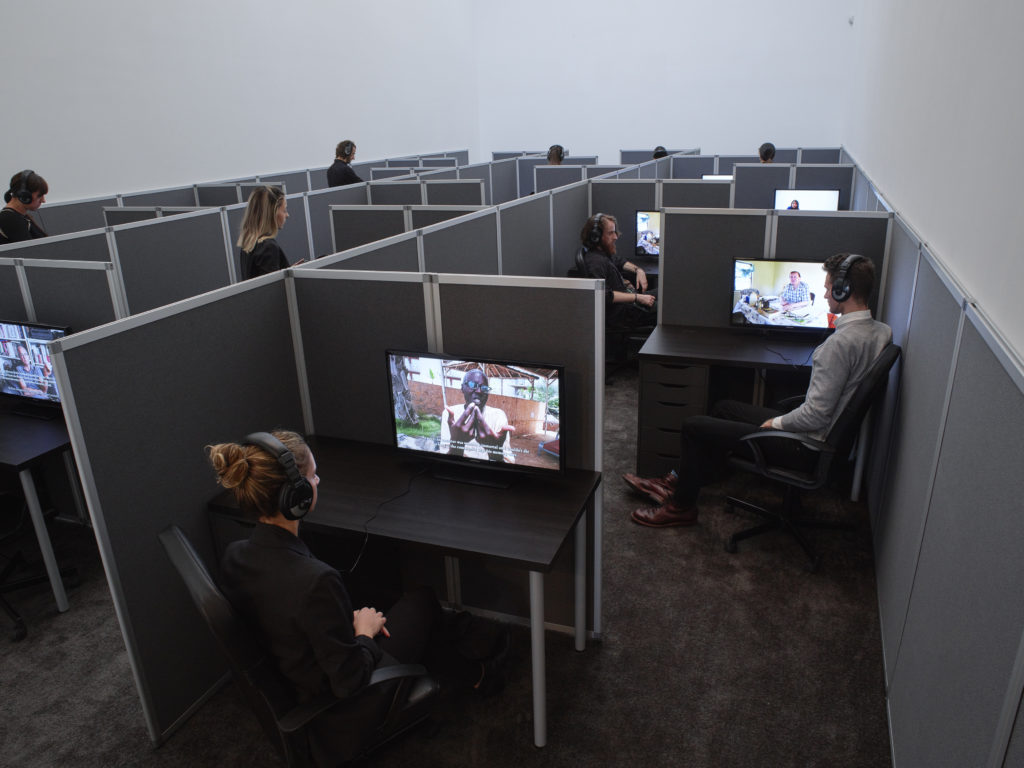What is the nature of the self? How do conceptions differ in Western and non-Western cultures? Can individual and collective traumas ever be “fixed,” or do certain wounds defy the notion of repair?
In “Reason’s Oxymorons,” French-Algerian artist Kader Attia surveys how different cultures, societies and disciplines grapple with questions of loss and damage. This fall, the Mildred Lane Kemper Art Museum at Washington University in St. Louis will present Attia’s immersive, 18-channel video installation — which debuted at the Biennale de Lyon in 2015 — in its Garen Gallery.
Known for investigating the effects of colonialism on non-Western societies, Attia frequently explores themes of injury and trauma. Of particular concern is the concept of repair and how it’s enacted around the globe. Though Western societies often conflate repair with a desire to fix or conceal imperfection, many non-Western cultures have found ways to incorporate and even celebrate its traces — an approach exemplified in certain forms of ritual scarification, or in Japanese kintsugi, a ceramic reconstruction technique that highlights the lines of fracture.
“Reason’s Oxymorons” elucidates but also complicates this dichotomy. Although grounded in research and referencing the seemingly straightforward approach of documentary filmmaking, “Reason’s Oxymorons” quickly reveals itself as something different.
The installation comprises a series of interviews that Attia conducted with a range of experts and practitioners, from psychiatrists, ethnographers and historians to musicians, storytellers and philosophers. Edited and sorted under headings such as “Reason and Politics,” “Genocide – Colonization” and “Modernity – Capitalism – Schizophrenia,” these conversations form a metaphoric library of psychiatric processes and approaches to mental health treatment that have developed throughout Europe, Africa and the Middle East.

The videos are presented on a series of television monitors installed within a labyrinthine network of anonymous gray office cubicles. The sterile, bureaucratic environment evokes an atmosphere of claustrophobia and seclusion, yet the maze-like form also invites viewers to wander from screen to screen, charting their own fluid and nuanced paths through a multiplicity of worldviews and therapeutic approaches.
At once rational and intuitive, “Reason’s Oxymorons” highlights the ambivalence modern Western societies continue to exhibit toward those from other cultures, especially refugees, and underscores the difficulties of assimilation. In the process, the installation raises essential questions about the human condition, the nature of the individual and the endless socio-psychological exchange between the individual and the communal.
As one practitioner asks, is the self a fortress, impervious to the surrounding world? Or is the self more like the wind and the air — a supple, elastic force capable of traversing many landscapes?
About the artist
Born 1970 in Dugny, France, Attia was raised in both France and Algiers. He has presented solo exhibitions at: the Museum für Moderne Kunst, Frankfurt, Germany (2016); KW Institute for Contemporary Art, Berlin (2013); Musée d’Art Moderne de la Ville de Paris (2012); The Institute of Contemporary Art, Boston (2007); and Musée d’Art Contemporain de Lyon, France (2006)
Major group exhibitions include the 50th Venice Biennale (2003), Documenta 13, Kassel (2012), the 13th Lyon Biennale (2015), the 12th Dak’Art, Senegal (2016) and the 54th Venice Biennale (2017). In 2016, Attia was awarded the Marcel Duchamp Prize, among France’s most prestigious arts awards. In the same year, his solo exhibition “Sacrifice and Harmony” was named German Exhibition of the Year by the International Association of Art Critics.
He lives and works in Berlin and Algiers.

Organizers and support
“Kader Attia: Reason’s Oxymorons” is curated by Meredith Malone, associate curator. Support for the exhibition is provided by the William T. Kemper Foundation; the Missouri Arts Council, a state agency; the Regional Arts Commission; the Hortense Lewin Art Fund; and members of the Kemper Art Museum.
Mildred Lane Kemper Art Museum
“Kader Attia: Reason’s Oxymorons” opens at the Kemper Art Museum with a public reception from 7 to 9 p.m. Friday, Sept. 8, and remains on view through Jan. 8, 2018. In conjunction with the exhibition, the museum will host a gallery talk by Malone on Sept. 9; a panel discussion on “Injury, Trauma and Repair” on Oct. 19; and a lecture on Attia’s work by independent curator Ellen Blumenstein Nov. 30 .
All events are free and open to the public. The museum is located on Washington University’s Danforth Campus, near the intersection of Skinker and Forsyth boulevards. Regular hours are 11 a.m.-5 p.m. daily except Tuesdays. The museum is closed Tuesdays.
For more information, call 314-935-4523; visit kemperartmuseum.wustl.edu; or follow the museum on Facebook, Twitter and Instagram.

